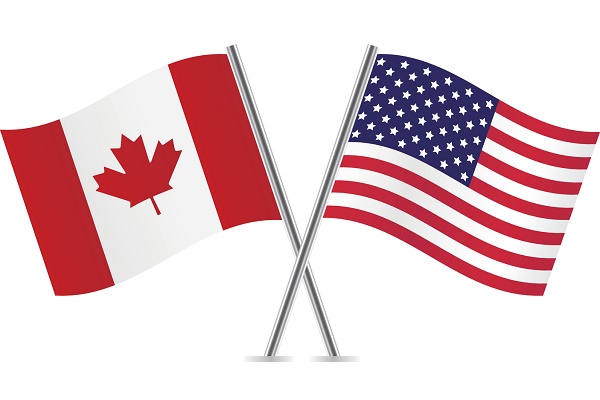Key differences in the US and Canadian banking industry

Chartered banks developed both in USA and Canada around the same time. Explain the early development of banks in both countries and how they differ?
Chartered banks are public corporations licensed by the federal government to operate a banking business within Canada (Bonham, 2017). The first bank in Canada was founded in 1817 under the name of Bank of Montreal having the same terms of the first bank of United States. When founded, it wasn’t allowed to issue notes, and wasn’t allowed to lend funds on mortgages. They used to provide the statements to the government on request only.
The modern commercial banking industry in the United States began when the Bank of North America was chartered in Philadelphia in 1791. Until 1863, all commercial banks in the United States were chartered by the Banking Commission of the states in which each operates (Hill, 2015).
Key milestones in the early ages of Canadian banking industry
- There were 3 attempts in 1792, 1807 and 1808 in Canada by some merchants to form banks, but all failed as they couldn’t obtain permission from the government. Finally in 1817, Montreal bankers were granted a charter by the British Government.
- In 1850, free banking era begins in Canada following the US.
- In 1914, Canadian banks are seen in a better state than the US banks as the rate of failure is 36% versus 22.5%.
- Some mergers and consolidations happen in Canada which brings the number of banks in Canada to 11.
- In 1964, Canadian government makes important reforms in the industry, 6% interest rate ceiling is lifted, and banks get allowed to enter the mortgage business.
- In 1967, Canada Deposit Insurance Corporation was formed.
- In 1980, foreign owned banks got allowed to operate in Canada.
- In 2008, which is the year of Great Recession, Canadian banking sector is rated by the World Economic Forum as the safest in the world (Desjardins, 2018).
Key milestones in the early ages of the US banking industry
- In 1791, the first bank of the US was chartered.
- In 1836, free banking era started, role of supervising banks was passed to the individual states.
- In 1860, banks got allowed to issue their own currencies.
- In 1864, free banking era ended.
- In 1907, J.P. Morgan helped end the Panic of 1907.
- In 1913, the Federal Reserve System was established.
- During Great Depression between 1930 and 1933, about 10,000 banks failed throughout the country as borrowers failed to pay loans back.
- In 1933, Federal Deposit Insurance Corporation was formed.
- In 1980, the Monetary Control Act was introduced allowing banks to merge, deregulate interest rates, etc.
- in 2010, right after the Great Recession years, Dodd-Frank was passed to strengthen the banking system (American Bankers Association (Ed.), 2020).
When it comes to differences between US and Canadian banking sector development, we can say that Canada almost all the time followed the US, learned from the US’ mistakes, and proceeded more cautiously. This general approach of Canada in its relationship with the US was noticeable in its actions in the banking industry too.
Key differences in the US and Canadian banking industry
- In Canada, number of the banks are limited but they have more branches. There are 28 banks in Canada while there are more than 7000 banks in US. The US population is 10 times more than Canadian population, but the number of banks is 250 times more.
- There is a difference in regulations and legal mindset between 2 countries’ banking sectors. US regulations focuses on confidentiality, customer security, accessibility, anti-money laundering issues, whereas the Canada’s focus is more safety and accuracy.
- The US has more of a mindset of the ‘’Too Big To Fail’’ approach, they are more risk tolerant, they take on more and higher risks and eventually fail hard from time to time (see Great Depression, and Great Recession years). Canadian banks are more humble when it comes to riding the high horse. As a result, for example in the 2008 crisis, many US banks went bankrupt, but none in Canada.
- Small U.S. banks keep operating because there is a restriction in the US that limits the ability of some banks to open more branches, so often the large banks are restricted from opening a nearby branch, and therefore, cannot drive the small banks out of business (Pruss, (N.d.).
References
American Bankers Association (Ed.). (2020). A History of America’s Banks and the ABA. Retrieved July 18, 2020, from https://www.aba.com/about-us/our-story/aba-history
Bonham, M. S. (2017). Chartered Banks in Canada. Retrieved July 18, 2020, from https://www.thecanadianencyclopedia.ca/en/article/chartered-bank#:~:text=Chartered%20banks%2C%20sometimes%20known%20as,a%20banking%20business%20within%20Canada.&text=Chartered%20banks%20in%20Canada%20accept,%2C%20commercial%2C%20and%20other%20purposes.
Desjardins, J. (2018). A Tale of Two Banking Sectors: Canada vs. U.S. Retrieved July 18, 2020, from https://www.visualcapitalist.com/canada-u-s-banking-differences/
Hill, A. T. (2015). The First Bank of the United States. Retrieved July 18, 2020, from https://www.federalreservehistory.org/essays/first_bank_of_the_us#:~:text=The%20Bank%20of%20the%20United,with%20a%20twenty%2Dyear%20charter.
Pruss, L. (N.d.). The Differences Between Banking in the US and Canada. Retrieved July 18, 2020, from https://thefinancialbrand.com/54467/comparing-united-states-canadian-banking-systems/#:~:text=Canada%20Has%20Fewer%20Banks,banking%20environment%20is%20more%20competitive.





